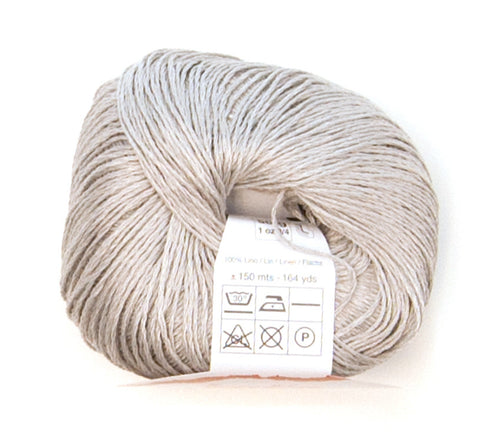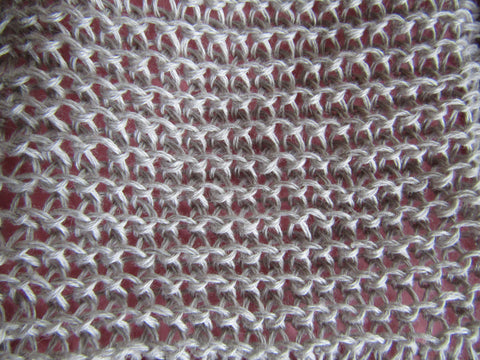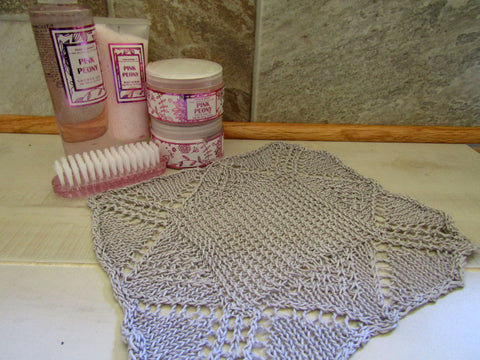Mary E. Rose is a very talented designer from central Ohio. She's part of our Independent Designers Program, and her pattern will be released next week. In anticipation of that, we asked her to write an article for you on how to successfully work with linen - a versatile fiber we're seeing more and more of. She has some great tips and a free pattern for you!
Swatching With Linen
by Mary E. Rose
It's nearly summer here in central Ohio, and that can only mean one thing: daytime and evening temperatures high enough that all those wonderfully wooly knits I have made through the years get cleaned, neatly folded, and put away for another season. It is always a bittersweet time because, not only do I love the process of creating knitted clothing and accessories, I love wearing them. Putting them all away is like saying goodbye to good friends that gave me hours of enjoyment in the making and more hours of enjoyment in the wearing!
When Sasha, the owner of Skein Shop, asked me if I would like to take on the challenge of creating a summer shawl using a linen yarn, I jumped at the chance to cure that problem. Hand knits that I could wear all summer sounded wonderful, but I had never worked with linen before, so I promptly searched the internet for more information about the fiber itself while waiting patiently for the yarn to arrive so I could swatch.
Making a Case for Knitting with Linen:
Linen is a natural material made from the flax (linseed) plant. It is much stronger than cotton, yet it can be very soft. Linen allows more airflow through its structure, giving your body the chance to "breathe". It's highly absorbent, yet it dries quickly. It is almost lint-free, non-allergenic, non-static, and it provides some UV protection. All of these points seemed to really make a case for knitting with linen...
And then the yarn arrived.

Katia Lino 100% in the ball is crisp and shiny. Where was that "very soft" that I had seen mentioned while doing my research? It's in the handling! Now you could, if you were more patient than I, skein the yarn, wash and dry it a few times, and have that linen yarn that is soft and nice to knit with. However, simply handling the yarn can also make it softer and easier to work with, so instead I got out my trusty ball winder and wound that ball into a cake. Then I wound that cake into another cake, and finally I did the same thing a third time. Much softer! Now it was time to actually get down to the business of seeing what this yarn would - and wouldn't - do.
Want to swatch along with me?
Ok, Let's Swatch!
Materials:
- Katia Lino 100% linen yarn, wound into a cake three times or more (Swatch used 20g)
- US 5 (3.75mm) needles, straights or circular for the body of the swatch, circular for the border
- Smooth waste yarn for the provisional cast on
- Stitch markers
- Large-eyed tapestry needle for weaving in ends
Gauge: 27 sts x 25.5 rows = 4" x 4" (~10cm square)
Instructions:
Using your favorite provisional cast on, cast on 20 stitches.
Rows 1-40: Knit all stitches through the back loops.
Row 41: Turn work 90 degrees, place unique stitch marker to designate beginning of round, yarn over, pick up and knit 20 stitches down one edge, place stitch marker, yarn over, pick up 20 stitches from provisional cast on, knit these stitches, place stitch marker, yarn over, pick up and knit 20 stitches along the third edge, place stitch marker, yarn over, knit 20 stitches to beginning of round marker (84 stitches)
Next and all even-numbered rounds: Knit all stitches, slipping markers as you come to them.
Beginning with Round 1 of the chart, work rounds 1-15, repeating the chart one time on each edge of your swatch. (Right click on the chart and select "open image in new tab" to view a larger version.)

Round 16: Purl all stitches, slipping markers as you come to them.
Finishing:
Bind off as follows: Knit 2, return both stitches to the left-hand needle and knit 2 together through the back loops, *knit 1, return two stitches from right-hand needle to left-hand needle and knit two together through back loops; repeat from * until all stitches have been worked. Pull end through final stitch and cut yarn, leaving a 9" tail for weaving in. Weave in your ends, but do not clip yet! Machine wash and dry several times. On final drying, remove from dryer while still damp, pin out square, and dry completely. After cloth is completely dry, you may trim your ends.
 The spa cloth before blocking. The spa cloth before blocking. |
 The spa cloth after blocking. The spa cloth after blocking. |
Measure your swatch cloth! Without stretching you should have a cloth that is 8 inches (~20 cm) square, which coincidentally is spot on gauge for a shawl designed for using Katia Lino!
What Did I Learn From My Swatch?

First, winding and re-winding the yarn really did make it softer to work with. Straight off the needles stockinette stitch looked uneven, which is why I opted to use twisted garter stitch for the body of my swatch. Also, linen loves texture! Both the twister garter and the 2/2 stitches drape beautifully with this linen yarn. Finally, avoid your super sharp, slick needles. Blunter points and wood or slightly textured needles worked best for me.
Tips for Working with Linen:
- Handle the yarn before starting to knit. Winding it into a cake or ball several times softens it up and makes it much easier to use.
- Blunt-tipped needles do not split the yarn as easily as sharper ones do.
- Use a textured or lace stitch to work with the linen, not stockinette where you are working against it.
- Join new yarn by knitting with one strand of the old and one strand of the new for a few stitches to anchor. When your project is complete, ensure you weave in those ends in both directions before washing. Wait to clip the ends until you have washed and dried your piece several times.
- Don't measure your gauge until after you have washed and dried your swatch at least once - that first washing can make a significant difference!
- And finally...linen swatches make excellent spa cloths :)


Leave a comment